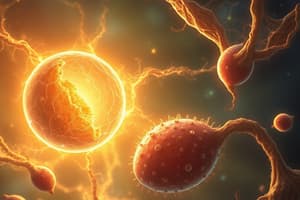Podcast
Questions and Answers
What are somatic cells responsible for?
What are somatic cells responsible for?
- Halving DNA content for fertilization
- Forming gametes in the ovaries and testes
- Undergoing mitosis to produce identical cells for growth (correct)
- Producing non-identical cells for reproduction
What occurs to the primary oocyte during the menstrual cycle?
What occurs to the primary oocyte during the menstrual cycle?
- It completes meiosis I and resumes division
- It grows but remains arrested in metaphase I until ovulation (correct)
- It develops into a primary follicle
- It pauses in prophase II until fertilization
Which phase of the menstrual cycle involves the shedding of the uterine lining?
Which phase of the menstrual cycle involves the shedding of the uterine lining?
- Secretory phase
- Luteal phase
- Proliferative phase
- Menstrual phase (correct)
What triggers the prevention of polyspermy?
What triggers the prevention of polyspermy?
What is the primary function of the corpus luteum?
What is the primary function of the corpus luteum?
What happens during spermiogenesis?
What happens during spermiogenesis?
What is the function of enzymes released from the acrosome?
What is the function of enzymes released from the acrosome?
What is amphimixis?
What is amphimixis?
What is the initial stage of prenatal development referred to?
What is the initial stage of prenatal development referred to?
What organ system primarily arises from the endoderm?
What organ system primarily arises from the endoderm?
How are fraternal twins formed during development?
How are fraternal twins formed during development?
Which structure forms from the ectoderm during development?
Which structure forms from the ectoderm during development?
What is the primary function of the placenta during pregnancy?
What is the primary function of the placenta during pregnancy?
What happens to the ductus arteriosus after birth?
What happens to the ductus arteriosus after birth?
Which congenital heart defect increases pulmonary blood flow?
Which congenital heart defect increases pulmonary blood flow?
What condition is commonly associated with spina bifida?
What condition is commonly associated with spina bifida?
Study Notes
Gametogenesis and Fertilization
- Somatic cells divide by mitosis to create identical copies for tissue growth and repair
- Gametes are produced by meiosis, which creates non-identical cells with half the DNA content
- Meiosis halves the DNA content to ensure a zygote with the correct chromosome number (46) after fertilization
Oogenesis
- Germinal epithelium becomes inactive after birth and no longer divides
- Primary oocyte grows in size after puberty but remains arrested in metaphase I until ovulation
- Menstrual cycle:
- A secondary follicle develops, and one primary oocyte completes meiosis I to become a secondary oocyte
- The secondary oocyte pauses in prophase II of meiosis
Ovarian and Menstrual Cycles
-
Ovarian cycle:
- Follicular phase (days 1-14)
- Luteal phase (days 15-28)
-
Corpus luteum secretes progesterone to prepare the uterus for implantation
-
Menstrual cycle:
- Menstrual phase (days 1-5): Uterine lining is shed
- Proliferative phase (days 6-14): Lining regrows and glands proliferate
- Secretory phase (days 15-28): Uterine glands secrete compounds for implantation
Spermatogenesis
- Occurs in seminiferous tubules of the testes
- Primary spermatocytes undergo meiosis I to produce haploid secondary spermatocytes
- Spermatids mature into spermatozoa during spermiogenesis
Events Leading to Fertilization
- Corona radiata: a layer of granulosa cells surrounding the oocyte
- Sperm penetrates the zona pellucida using enzymes from the acrosome
- Polyspermy is prevented by oocyte activation, which triggers cortical granule release, hardening the zona pellucida and digesting remaining sperm receptors
Fertilization and Early Development
- Amphimixis: mixing of paternal and maternal DNA during the first mitotic division of the zygote
- Cleavage: division of the zygote into smaller cells called blastomeres
- Implantation: the blastocyst embeds into the uterine lining
Development Stages and Twins
- Prenatal development stages: pre-embryo, embryo, and fetus
- Identical twins form from splitting a single zygote into two inner cell masses
- Fraternal twins form from the fertilization of two separate oocytes by two different sperm
Germ Layers and Organ Formation
- Ectoderm:
- Brain
- Spinal cord
- Nerves
- Skin
- Mesoderm:
- Muscles
- Bones
- Heart
- Kidneys
- Connective tissue
- Endoderm:
- Gastrointestinal tract
- Lungs
- Various glands
Placental Circulation and Fetal Development
- Placenta: supports fetal development by exchanging nutrients and waste between fetus and mother
- Umbilical arteries: carry deoxygenated blood
- Umbilical vein: carries oxygenated blood to the fetus
Neural Tube and Congenital Disorders
- Spina bifida: neural tube defect where spinal cord content protrudes outside the vertebrae
- Hydrocephalus: excess cerebrospinal fluid accumulates, often causing mental deficits and nerve dysfunction
Congenital Heart Defects and Risks
- Leading cause of neonatal death after prematurity
- Maternal factors increasing risk: rubella, diabetes, medication use during pregnancy
- Types of congenital heart defects:
- Lesions increasing pulmonary blood flow
- Lesions decreasing pulmonary blood flow
- Obstructive lesions
- Mixed lesions
Lung Development and Premature Births
- Canalicular phase: (weeks 17-27) immature alveoli form and lung vascularization increases
- Insufficient surfactant causes infant respiratory distress syndrome (IRDS) due to alveolar collapse
Postnatal Changes and Transition to Neonatal Circulation
- Ductus arteriosus and foramen ovale close after birth to separate pulmonary and systemic circulations
- IRDS symptoms: rapid breathing, cyanosis, nasal flaring, fatigue
- IRDS treatment: artificial surfactants, mechanical ventilation, oxygen therapy
Studying That Suits You
Use AI to generate personalized quizzes and flashcards to suit your learning preferences.
Related Documents
Description
This quiz focuses on the processes of gametogenesis and fertilization, detailing how somatic cells and gametes are formed. It explains oogenesis and the ovarian and menstrual cycles, highlighting the key phases and hormonal influences involved in these reproductive processes.




